I’ve put together an easy-to-play-with online model of methane in the atmosphere. I’m going to use it for teaching along with the rest of the Understanding the Forecast webmodels, but it was designed to be relevant to the issue of abrupt new methane burps as we’ve been ruminating about lately on Realclimate.
The model runs in three stages: a pre-anthropogenic steady state which ends in the model year
-50, addition of a new chronic source for 50 years (from human activity),then a spike beginning at model year 0 (supposed to be today) and running for 100 years into the model future. Here are results from the “worst case scenario” in the last post (whether you believe it is the true worst case or not): 200 Gton C over 100 years.
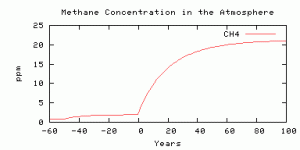
Looks like we got the factor of 10 methane increase about right.
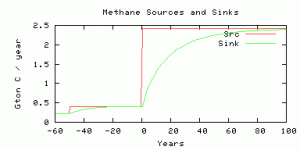
Source and sink of methane in the model.
The lifetime of methane in the atmosphere, used to calculate the methane sink in any time step, is parameterized as a function of concentration following Schmidt and Shindell (2003).
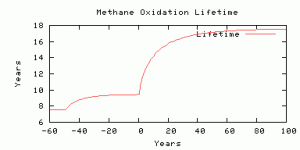
The atmospheric lifetime of methane, used to calculate the sink flux.
The radiative forcing is parameterized from output from the NCAR model, scaled by an efficacy factor of 1.4 from Hansen et al, (2005). The radiative forcing is compared with Business-as-usual CO2 radiative forcing with the model year 0 corresponding roughly to year 2010, and with CO2 rising at 0.65% per year. The methane radiative forcing before year 0 is not time-realistic because the real human sources did not switch on instantaneously 50 years ago, but you can compare the future evolution of radiative forcing from CO2 and methane, from year 0 onwards.
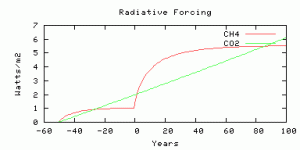
The radiative forcings of CO2 and methane compared. The scenario is more-or-less comparable to 750 ppm CO2, as we thought.
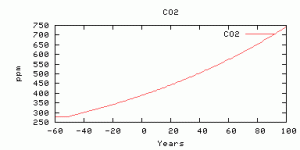
The CO2 concentration used to generate the last figure.
Timing is everything
Four simulations with the same amount of carbon released as methane in the “spike”, on different time scales for the release.
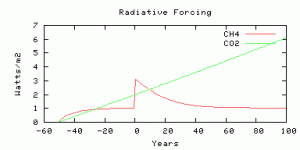
10 Gton C release in 1 year — the spike.
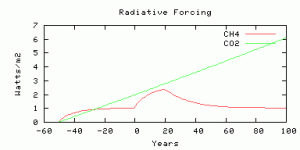
Same spike but not as sharp: 10 Gton over 20 years.
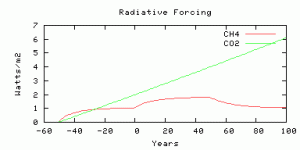
Same 10 Gton but spread over 50 years.
Enjoy. Go and get your swamp gas on, and give the poor model planet your worst. Bwahahahahaha!
References
- G.A. Schmidt, and D.T. Shindell, "Atmospheric composition, radiative forcing, and climate change as a consequence of a massive methane release from gas hydrates", Paleoceanography, vol. 18, 2003. http://dx.doi.org/10.1029/2002PA000757
- J. Hansen, M. Sato, R. Ruedy, L. Nazarenko, A. Lacis, G.A. Schmidt, G. Russell, I. Aleinov, M. Bauer, S. Bauer, N. Bell, B. Cairns, V. Canuto, M. Chandler, Y. Cheng, A. Del Genio, G. Faluvegi, E. Fleming, A. Friend, T. Hall, C. Jackman, M. Kelley, N. Kiang, D. Koch, J. Lean, J. Lerner, K. Lo, S. Menon, R. Miller, P. Minnis, T. Novakov, V. Oinas, J. Perlwitz, J. Perlwitz, D. Rind, A. Romanou, D. Shindell, P. Stone, S. Sun, N. Tausnev, D. Thresher, B. Wielicki, T. Wong, M. Yao, and S. Zhang, "Efficacy of climate forcings", Journal of Geophysical Research: Atmospheres, vol. 110, 2005. http://dx.doi.org/10.1029/2005JD005776
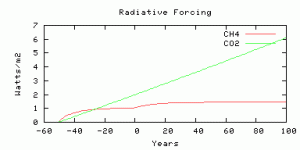
Leland Palmer @200 — Solar PV costs what it costs; feed-in tariffs simply transfer the burden from the solar PV owner to the tax payers. Unfortunately biomass energy can only be a boutique solution has humans have already appropriated around 60% of net primary production.
More generally, Brave New Climate [linked on the side bar] is a place to discuss energy solutions with Real Climate almost entirely devoted to, well, the real climate. Lets try to keep it so.
Leyland – my compliments on your perseverance.
I share much of your concern over the dismissal of the relevance of the methane threat. To imply that it is “Much ado about nothing” seems to me a gift to the deniers, and anyway premature given that we’ve yet to see the report on last summer’s ESAS research trip. Notably Dr Shakhova’s interview on Skeptical Science does not offer any contradiction of Semiletov’s account (Independent) of the scale and number of plumes over a kilometre across.
Ray’s persistence in ignoring the difference between an ESAS permafrost response to a warm period before 8,000 yrs of inundation and its response to present rapid warming after that period seems to me a partisan position. Given the ongoing loss of arctic albedo, the ongoing rise of incoming currents’ delivery of heat energy to the Arctic Ocean, and the ongoing increase of global rainfall and also its ongoing northward retreat – (implying greatly increasing warmer runoff into the Laptev Sea after flowing over vast areas of warming tundra) a lack of real concern over Dr Shakhova’s warning seems more than a bit relaxed.
Professor Archer’s model appears to reflect this position, and certainly warrants further development. Besides fixing the glitch whereby changing the ’source flux’ value changes the CH4 ppm, watts/m2, etc, from yr-50 to yr0, additional data is needed for a plausible output to be shown. Including CO2 from CH4 decay is one such item, but that from permafrost melt is far more relevant. As you’ll know, Schuur et al projected a flat 2.7% of permafrost carbon output being emitted as CH4, which implies 98.6TsCO2 for each tonne of CH4 released. Given that the model intendedly reflects all arctic CH4 outputs, that ratio should be reduced to reflect Arctic Ocean and ESAS outputs as well. After much study of the AIRS plots I’d tentatively propose a present ratio of annual CH4 outputs of 1.0-ESAS to 2.0-Arctic Ocean and Canadian archipelago to 2.0-permafrost. This would imply a revised output ratio of about 40Ts CO2 per 1.0T CH4 across the arctic. No doubt Prof. Archer could provide a more accurate ratio if he saw fit.
Another helpful addition would be allowing a variable percentage rate of change in emissions rather than using an arbitrary ’source flux for a period of years’. The NOAA/NSIDC study indicates an average rise in carbon output from permafrost of close to 8.2%/yr between 2010 and 2020, (with that percentage rate of change declining thereafter as the study excluded the diverse direct accelerators from arctic amplification and also the timelagged warming from permafrost’s own GHG outputs).
A further very informative change would be to stack the several sources of additional forcing to show their combined effect, rather than merely providing them individually for comparison.
However, the problem with using the ESAS 50Gt CH4 threat, or the global Clathrate Gun threat, as campaigning issues is that they each form a gift to deniers – given the lack of scientific consensus on their probability and timing. Once the 2011 ESAS research is published, this position may change, but Shakhova’s call for further research implies that it may be far from conclusive, so a working consensus may take years or decades to achieve.
Meanwhile, I’d strongly urge that campaigning should be based on the quantifiable prognoses for a ‘Habitable Climate AWOL’ outcome. It is less dramatic than a potential methane eruption but the proximity of our becoming committed to that outcome is also far more demonstrable. Given the quantified impacts of the major feedbacks (including the reported forcing-equivalence of current albedo loss to ~30% of anthro-CO2 outputs, and the microbial peat bog decay under elevated CO2 with DOC emissions rising at ~6%/yr) there is a strong case for proposing that we are already at or near being committed to feedback outputs exceeding the carbon sinks. They would thereby becoming self fuelling, with inevitably genocidal results, regardless of the rate of control of anthro-CO2e outputs.
Scientific support for the formal goal of avoiding the feedbacks taking over by cutting anthro-GHGs to provide a 2.0C limit on warming – is already fragmenting, not least because conservative institutions such as the Hadley Centre acknowledge that it offers only a 46% chance of doing so, and that this calculation actually includes an assumption of increasing natural carbon sinks.
It will take time for a scientific consensus to form around the recognition of the necessary action but insufficient efficacy of cutting anthro emissions, but it will remain a far more cogent influence over international diplomacy than the potentially abrupt threats because the incremental growth of feedback outputs can be tracked and publicized year by year, while a methane eruption hasn’t happened until it happens.
I guess you’ll have seen as much as I of the conventional mindset regarding pressure on ecosystems that :- “It hasn’t collapsed yet, therefore our conduct is sustainable” ?
Regards,
Lewis
Leland Palmer #194, you stated:
How is this a flaw in “an online model of methane in the atmosphere”?
As I’m just another layman mouthing off, I’m not sure if this is also covered by David’s parameterization. But anyway, if you look e.g. at Isaksen’s 7xCH4 case, they get a 3.6 W/m2 total radiative forcing, of which 0.2 W/m2 (6%) from secondary CO2. A difference, but not a crucial one.
I wouldn’t trust my feelings too far if I’d been told otherwise by the experts not once, nor twice, but three times.
I don’t see how that makes sense. GHGs cause forcings, the sum of forcings causes a warming, the warming leads to a water vapor feedback. The water vapor only cares how hot it gets, it doesn’t care what mix of gases was doing the heating.
I don’t think Isaksen’s stuff implies anything of the sort. Far as I can see, Isaksen et al. do not calculate temperatures or climate sensitivity, but total radiative forcings from methane. The forcings are indeed greater for rapid rates of methane release.
David appears to apply a different multiplier than Isaksen et al., but that’s probably partly due to their defining direct vs. total forcings differently (Gavin had a note on this).
Bottom line: David’s model ends up with a total RF of about 5 W/m2 from about 10xCH4 (eyeballed), whereas Isaksen et al. with 5.4 W/m2 from 13xCH4. They may not be entirely comparable (different release rates and time horizons). Still, they’re close enough that I don’t really see what the issue is.
Lewis: “Ray’s persistence seems to me a partisan position.”
Look, moron, if you consider requests for fricking evidence to be a partisan position, then you are beyond help or redemption. So pardon me if I don’t hold your fricking hand when you tell me you are scared of the dark or the monster under the bed or whatever else it is you are scared of.
We’re trying to do science here. That deals in evidence, not in, “well it could be,” or unsubstantiated fearmongering. Anyone familiar with my positions on this board or elsewhere would testify to my bona fides in demanding denialists pay attention to evidence. I have been more than outspoken in calling for action. I’m not about to take it easy on you or Leland when you equally cavalierly ignore evidence. So, I’ll tell you the same thing: Until you do the goddamned math, you got bupkes. Now let the adults talk, sweetie. It’s past your bedtime.
Well Ray, that’s twice you’ve misquoted me and then responded to your inventions, rather than addressing the issues proposed.
121 LC – “. . .it is plain that ESAS has had millennia of slow natural warming since the holocene plus the radical anthropogenic warming of recent decades, and may thus be in an increasingly unstable condition, . . .”
127 RL – “First, we have not had a millennium of steady warming.”
202 LC – “Ray’s persistence in ignoring the difference between an ESAS permafrost response to a warm period before 8,000 yrs of inundation and its response to present rapid warming after that period seems to me a partisan position.”
204 RL – “Lewis: “Ray’s persistence seems to me a partisan position.”
Quite why you feel the need to indulge in pathetically tedious invective is your problem. Your various arrogant and bullying comments across these threads, while persistently ignoring valid considerations, does nothing to raise the cogency of your arguments – on the contrary, they appear to be an increasingly emotional attempt to bolster your own optimism bias.
I know little of US codes of conduct in science, but in the UK this is not how scientific discussion is conducted.
Regards,
Lewis
[Response: Please do not get caught up in attacks on other commenters (and this goes for everyone). – gavin]
Hi CM-
David is certainly an expert, there is absolutely no doubt about that.
But he also co-authors scientific papers with ExxonMobil chief scientist Haroon Khesghi:
[edit – extensive ad hom argument deleted. Either stick to substantive issues or take it elsewhere.]
Lewis, It’s simple. You aren’t discussing science. You are looking for monsters under the bed. Here’s how things are supposed to go. First, you estabish that you have a credible threat. That means that conservatively, there is reason to believe that the situation could have severe consequences and has a reasonable chance of being realized. You DO NOT simply speculate that “well it could be really bad.” You show that it could be really bad. You know, actually present evidence.
I insist that the so-called skeptics pay attention to evidence. I will not expect less of those who are convinced of anthropogenic warming. If I am a partisan, then my cause is ensuring that we apply proper methodology in both science and risk mitigation. Is that OK with you, or do you have a problem with that position?
I hear Dr. Radbury’s exhortation to do the math.
Here is my feeble attempt to shut up and calculate:
Following the comment by Mr. John E. Pearson, on the 22nd of January, 2012 at 7:23 PM:
“melt-mass transport of heat laden water-diffusion of heat into clathrate”
i inject 1 Kg meltwater (330 odd kJ/kg is Latent heat) into clathrate. Max. concentration of methane in ice is around 1:8, Latent heat to dissociate clathrate to water + gas is around the same as to melt ice.
i have a handy maxwells demon that moves the heat obtained by refreezing the original 1 Kg of meltwater into breaking down 1 Kg clathrate. i get 7/8kg new water and 1/8kg methane. I inject the 7/8 kg water into clathrate and get 49/64 Kg water back and so on… eventually i liberate 1 Kg methane.
there is around 1e13 sq km permafrost, so if i do 1kg (1 litre) water per sq. Km. per year i liberate 1e13 kg CH4 or around 10 Gton/yr
1ton per year (1 cubic meter water) per square km buys me 10,000Gton/yr this is an average rainfall of 1/10 cm rain per year injected into the permafrost.
lets say that such percolation melt is only 10% effective
thats still only an equivalent of 1 cm/yr rainfall.
these are small amounts compared to the hundreds of Gton of ice melting in GIS and WAIS, and very small compared to deep ocean storage.
ok, so someone tell me where my astronomical orders of mag error is ?
please? i do know that to get it rite you have to put in the real dissociation enthalpies and the perc coefficients and so on and so forth…
sidd
i see one problem with my calculation: not all permafrost areas have clathrate deposits underlying…i have no idea what the factor there is
sidd
Sidd@208,209,
Well yeah, the proportion with clathrates and the invocation of Maxwell’s Demon, but other than that…
Congratulations, Leland, you can pick up the ashes of whatever credibility you may once have possessed at the door. Don’t let it hit your butt on the way out.
This is a very nice start.
http://ejde.math.txstate.edu/conf-proc/17/a1/alexiades.pdf
Dr. Ray Ladbury, I do apologize for misspelling your name in my post. My eyes and fingers fail me more often as I age.
sidd
Mr. Pearson, I am aware of the Alexiades reference, but thank you nevertheless. I note with regret that the word “experiment” occurs only once therein…
sidd
Hi Ray-
Sticking strictly to the science:
The CO2 curve in David’s model is fixed. No matter how much methane is emitted, no matter how much permafrost rotting occurs, we are stuck with business as usual CO2, in David’s model.
For large releases of methane, this is simply unrealistic.
A common theme seems to be emerging regarding methane. Large injections of methane into the system can both overwhelm the oceans’ ability to oxidize it and overwhelm the hydroxyl radical oxidation mechanism once it is in the atmosphere.
For small releases of methane, these shortcomings of the model are not particularly important. For large releases, the model is actively misleading, and gives a misleading impression of the duration of the crisis. Due to secondary CO2 and atmospheric chemistry side effects, any large releases of methane will produce tens or hundreds of ppm of CO2, persisting for many thousands of years.
What appears to be emerging is a general model of most past mass extinctions. That model is the clathrate gun hypothesis, modified by ocean and atmospheric chemistry effects of methane. Methane is strongly reducing, and is a sort of holdover from our early atmosphere. Methane can both locally overwhelm the Arctic Ocean’s ability to metabolize it and once in the atmosphere it can overwhelm the hydroxyl radical oxidation mechanism, increasing its own lifetime.
From Isaksen:
Note that Isaksen does not even try to predict atmospheric chemistry effects beyond 13 ppm of methane. According to David’s model, substantial releases of methane would result in much higher levels of methane than this. Note that the trend in forcing is not encouraging- at 13 ppm of methane concentration, forcing due to increased lifetime, secondary CO2, and atmospheric chemistry effects is up to 400 percent of that forcing directly attributable to methane itself.
The End Permian mass extinction, plausibly due to a methane catastrophe triggered by CO2 released from the Siberian Traps volcanism, killed on the order of 95 percent of all life on earth at that time. There have been several other mass extinctions and ocean anoxic events that fit this general model. Compared to our present utterly nonrandom and extremely fast release of CO2, these events occurred relatively slowly, in several stages. Note that these stages are likely due to secondary CO2, with its high persistence in the atmosphere, setting off new rounds of hydrate dissociation.
According to the standard model of stellar evolution, the sun is about two percent hotter now than it was during the End Permian. Hansen says this is equivalent in forcing to about 1000 ppm of CO2.
Suppose the likelihood of the above scenario was one percent. In that case, since this scenario threatens most human beings on the planet, the risk is huge, and strenuous efforts to avoid that scenario would be justified.
Correction, at the end of the fourth paragraph from the bottom of my post # 215:
Make that:
…directly attributable to methane itself with it’s current atmospheric lifetime.
> likelihood … one percent…. strenuous efforts
> to avoid that scenario would be justified.
Now, say you have a hundred scenarios that are one percent likely.
And fifty scenarios that are two percent likely.
And twenty-five that are four percent likely, and so on.
Up to a handful of scenarios that are more likely than not.
Top one is, say, warming from burning fossil fuels, call it — most likely.
If you’re lucky, you’ll pick the one among many one percent risks that’s actually going to be the one that, in the real world, is really happening, and dedicate the world’s effort to that particular cause.
If you’re an energy company interested in tapping natural gas under permafrost, you might be lucky in a whole different way, of course.
You might convince people that it’s a public service as well as a profitable business, in the short term.
But if the methane isn’t going to melt more than 100x faster than in the past, you’ll have wasted the effort you could have focused on the main problem, and put all that methane up for burning to the drillers’ profit.
Do you feel lucky?
214 Sidd: “John” will do.
After a little more thought I don’t like the mechanism I proposed the other day. I think the latent heat is so high propagation failure would be nearly certain unless the clathrates were already near melting, in which case the proposed scheme is not particularly relevant.
Hi Hank-
I was using the one percent probability of a methane catastrophe as an argument. Even a small chance of an utter catastrophe carries a substantial risk, if risk is defined as insurance companies do by multiplying consequences of an event by probability of that event.
But the true probability of a methane catastrophe if we continue on our present course is likely much higher than that, in my opinion.
Looking at the geological record, there are discontinuities, often marking the boundaries between geological periods. The End Permian mass extinction is the boundary between the Permian and the Jurassic periods, of course. An event happened which was so severe it wiped out 95 percent of the life then existing, and the empty ecological niches produced allowed the dinosaurs to evolve to fill those empty niches.
Many of these boundaries are marked by severe discontinuities in the carbon isotope C12/C13 ratios, that have been attributed to several trillion tons of carbon from a living source entering the active carbon cycle. The methane hydrates are very likely this carbon source. Methane hydrates are simultaneously abundant, volatile, capable of positive feedback reinforcement of their own release, and are derived from a living source, and so have an anomalous C12/C13 ratio- fitting the clathrate gun model.
If methane catastrophes have occurred several times in earth history, and have occurred as recently as 50 million years ago for the PETM, then likely the potential for us to set one off is high, not low.
Our current rate of change of CO2 emissions might actually guarantee a methane catastrophe- we don’t know.
Everything appears to be happening decades ahead of schedule- melting icecaps included. We cannot responsibly take the sort of risk involved in business as usual (or above) emissions of CO2.
John., would you expand on the sentence “…tbelow the he latent heat is so high propagation failure would be nearly certain unless the clathrates were already near melting, …”
“Self preserved” clathrates survive in the metastable zones pf P and T, so these metastable inclusions are actually above the T and below the P of the hydrate stability zone. I wonder if these are in the “super warmed” or “hyper warmed” regions (super warmed is when the latent heat absorbed by dissociating clathrate would be enough to cool the mass of back below the dissociation temperature, hyper warmed is when the heat absorbed would be insufficient to cool the mass of clathrate back below the dissociation temperature.)
sidd
Hi CM:
It’s definitely a flaw if that model claims to be a worst case scenario, with some definite relationship to the real world, CM. Secondary CO2 has been important in past apparent methane catastrophes, and appears to have set of further rounds of hydrate dissociation. What took hundreds of years in past methane catastrophes could take decades in our present situation with our geologically instantaneous and unnaturally consistent releases of CO2.
From David’s description of his model:
This is business as usual CO2, no matter what happens to the methane.
Yes for small releases, the secondary atmospheric chemistry effects that Isaksen models- also left out of David’s model, by the way- would be important. Since Isaksen’s results are new results, it’s hard for me to see how David could be including them in his model.
Good point, but the two statements are equivalent. The bottom line is that more forcing from more greenhouse gases including stratospheric water vapor, tropospheric ozone, and stratospheric hydroxyl radical results in a BIGGER water vapor feedback.
David does include increased methane lifetime from exhaustion of the hydroxyl radical oxidation mechanism, I’ll give him that. He doesn’t include ocean exhaustion of methane oxidation, though, leaving it up to the user to input steadily increasing methane inputs into the model…which is not possible because only linear inputs are allowed.
My main problem with the model is that it appears to me to give unrealistic long term results and consequences, and I still have concerns about the water vapor feedback being included from more different sources of forcing, occupying different infrared absorption bands.
Given the inputs to the End Permian, for example, I think that David’s model would show a brief bump of methane forcing followed by a quick decline.
What actually occurred according to the clathrate gun model of that extinction was further rounds of methane release probably set off by secondary CO2 and atmospheric chemistry effects. Over about 80 thousand years, this resulted in a severe mass extinction, moving from the oceans which likely became anoxic, to the land, apparently. Some have argued that what cause the land based extinctions was actually hydrogen sulfide from the anoxic oceans, combined with severe drought and rapidly changing climate.
How to kill off (almost) all life: the end Permian extinction event
Seems to me David’s model goes as far as watching Wiley Coyote treading air well past the edge of the cliff — you’re asking him to add gravity to the model so you can see where the coyote goes after that point.
I dunno. Seems to me clear enough as it is.
By the way, CM-
Greenhouse gas forcing is logarithmic to concentration. Each time a new greenhouse gas is injected into the atmosphere, it starts out on the steep part of its forcing vs concentration curve. This is because infrared absorption bands start to get saturated as concentration increases, as you know. That is why methane is currently considered “25 times worse than CO2 when its effects are averaged over a century”. It is present at around 1800 ppb, so is still in the steep part of its forcing versus concentration curve, as I’m sure you know as well as I.
It seemed to me when I read the Isaksen paper that we were multiplying the problem considerably by adding greenhouse gases presently in the atmosphere at very low concentrations via atmospheric chemistry effects of methane. Tropospheric ozone is presently at very low levels, for example. Stratospheric water vapor, as well, I believe. I’m not sure about hydroxyl radical, but I seem to remember it is present in the atmosphere at very low concentrations at present, due its chemical aggressiveness and short lifetime. We haven’t talked about nitrous oxide, but I believe there is speculation that anoxic oceans could start to produce that as well.
So it’s hard for me to believe that David’s model contains these new, startling atmospheric chemistry results, or their resulting water vapor feedback. He’s going to have to give me more than a blanket assurance that they are included- he’s going to have to show me how.
Looking at the graphs of infrared absorption bands, I can imagine the ozone band getting much wider as concentration increases, for example. I can imagine the long complex water vapor bands with their broad tails rising almost like curtains as concentration of water vapor increases with temperature.
[Response: We can all imagine an unlimited number of bogeymen under the bed, but having to show you personally that each of your imaginings isn’t going to pop up and bite you is neither possible nor interesting. There would indeed be knock on effects on strat water vapour, OH and O3, but none of these rise to anything like the impact you appear to be imagining. Conversely, the confidence that you exhibit on the exact cause of the PT extinction, the state of the hydrate reservoirs 250 million years ago etc. is hugely over-estimated. That period remains mysterious for the very good reason that it happened 250 million years ago and all evidence is extremely partial, indirect and sparse – there have been many theories for this event, and I can guarantee there will be many more. And as for the PETM, the only extinctions that occurred were in deep sea benthic foraminifera. – gavin]
Leland,
In science, you don’t get to assume there’s a 1% chance of catastrophe due to a particular threat–you have to show it.
Leland Palmer:
Please explain to me why I should pay any attention, or even read, your repetitive and extravagant extrapolations when you are not an expert. I prefer to get my science, outside of my own area of expertise, from the researchers who are actually publishing science.
Steve
Hi Gavin
Yes, thank you Gavin.
I do believe you have the shoe on the wrong foot, though, in my opinion.
The correct question should be- what do we want to bet that these plausible interpretations of the fossil record are wrong?
Do we really want to be the world on it?
For the sake of fossil fuels?
[Response: ??? – gavin]
Hi Steve-
Oh, I explained some of that in the post that was deleted. Some of this has to do with the existence of money and influence in the real world.
I do not think that you should believe anyone blindly, or put too much assurance in any source of information. The financial interests involved in this debate are immense. ExxonMobil, for example, has profits in the 30-40 billion dollar range per year on gross sales in excess of 400 billion dollars. That’s bigger than the gross national product of most countries. The oil and natural gas under the arctic sea ice is likely worth trillions of dollars, and methane from the hydrates is also worth trillions, if it can be tapped.
Don’t bet the world on any information from anyone, certainly not in such a complex situation, with so much at stake.
Oh, another reason you should listen to me is that it’s not really me that you are listening to. It’s Isaksen and Isaksen’s general atmospheric chemistry model talking about methane atmospheric chemistry effects, among other sources including the IPCC reports. It’s some guys from Lawrence Berkeley Laboratory, Los Alamos, and their man-years of hard work on their model showing resource depletion in the Arctic ocean interfering with ocean oxidation that you should listen to. It’s Benton and Twitchett you would be listening to about the End Permian, among others.
Leland,
You aren’t speaking for Isaksen or anyone else. Let us know about current research but please don’t attribute your own inferences to them.
And please quit drawing innocent bystanders into this disgraceful conspiracy theory about Exxon influencing scientists who are obviously not on their side. Keep this kind of stuff stuff for the Curry thread.
Let me ask you what I asked other methane alarmists before: what practical action do you think is justified by methane-realted risk that isn’t already justified without reference to methane? I got no answers so far but it seems some methane alarmists are interested in banning beef or something. Do you have more serious proposals in mind? Can you provide some kind of quantitative risk analysis? If not, please work this stuff out before pointing fingers.
Leland,
Well, except Isaksen isn’t hiding under the covers afraid to look out. Isaksen has a hypothesis. It bears looking at. It is not, as yet, sufficiently credible to cause us to stop the global economy. We do not have a sustainable energy economy ready to deploy and take the place of the current unsustainable fossil-fuel based economy. We would be a whole helluva lot closer to that goal than we are if we had heeded warnings in the ’70s of imminent shortages of petroleum or in the 80s and 90s of imminent climate change. We as a species decided to ignore these threats.
Now we are stuck with an unsustainable energy economy, an unsustainable population and hoping against hope that we can buy enough time to avert disaster. As a result, we must know that a threat is indeed credible before we can devote scarce resources to its mitigation. Welcome to the real world.
Hi Gavin-
I thought that answer was clear. Here it is again:
Do we want to bet the future of the biosphere that the clathrate gun hypothesis augmented by ocean and atmospheric chemistry effects of methane is wrong?
Shouldn’t we be cautious, and humble about our ability to predict the outcome of such a snarl of interlocking positive feedback loops?
Shouldn’t the existence of mass extinctions and oceanic anoxic events in the fossil record make us more cautious, instead of less?
> what do we want to bet that these
> plausible
> interpretations of the fossil record are wrong?
Plausible? If they’re plausible to the scientists, that’s where research will happen.
If not, you should look hard at whether you’re being used for political ends to push investment into drilling methane sources before their stability is known.
It’s clear that a methane hydrate layer drilled and sucked out is going to pull in more water and continue to evolve gas. There are gas wells mentioned earlier that just keep on producing gas long after they were expected to tap out, and likely that’s from releasing methane from clathrate — provoked by drilling into the source.
Your cautionary message should be ‘hands off hydrates til we know what’s happening’ — right?
Then we agree.
This is a feature if you’re drilling for gas.
It’s a bug if you’re a climate scientist concerned about methane.
Leland,
May I make a couple of substitutions.
Do we want to bet the future of the biosphere by not having the ability to exterminate invisible pink unicorns who threaten the very fabric of space time.
Both threats are equally established.
Hi Ray-
There are trillions of tons of invisible pink unicorns on the continental shelves of most continents and in the Arctic? Invisible pink unicorns, capable of overwhelming the ocean and atmospheric mechanisms of unicorn oxidation, and increasing their lifetime in the atmosphere? Invisible pink unicorns, with greenhouse potency 75 times that of CO2, if their effects are integrated over a 20 year period?
Who knew? :)
Seriously, though, there are trillions of tons of methane hydrates. And they are capable of overwhelming the ocean oxidation mechanisms in the Arctic, over a 30 year period- not according to me, but according to Lawrence Berkeley Lab and Los Alamos National Labs.
According to Isaksen’s state of the art general atmospheric chemistry model, large emissions of methane are also capable of overwhelming the hydroxyl radical oxidation mechanism in the atmosphere, and increasing its own greenhouse potency by this mechanism. David’s model includes increase of methane lifetime by overwhelming the hydroxyl radical, by the way, so I assume you’re not accusing him of pink unicorn fantasies as well.
Yes, thank you for your efforts to defend the global economy, Ray. I wasn’t aware that defending the global economy was a purely scientific pursuit, though. But delaying conversion to renewable sources of energy, when the existing fossil fuel supply system has ludicrous levels of greenhouse side effects in return for small amounts of useful heat of combustion is foolish, in my opinion.
We only spend five percent of our incomes on energy- far less than past societies, in many cases. If it was seven percent of our incomes for energy supply, or even ten percent for a while, that would certainly not kill the economy.
We can live and do fine with renewable energy sources, Ray.
But can we live and do fine with tens of gigatons of hydrate methane shooting into the atmosphere?
The available science says we cannot, regardless of your assertions.
So, Leland, do I understand you correctly?
Your cautionary message is
“Don’t mess with drilling into hydrates til we know what’s happening”
— right?
Leland,
OK, by all means convert to a totally renewable energy economy. Don’t worry. We’ll wait.
What freakin’ planet do you live on?
Do you actually think that this is all easy and that the sole reason why we don’t have a renewable energy economy and a flying car and a frickin’ pony, for that matter, is because of ebil scientists?
220 Sidd: I am on vacation and away from the internet mainly (Hallelujah). In any case I prefer to hold this discussion off-line. You can reach me via my gmail account. use my first name middle initial and last name with no punctuation.
Leland, could you please stop posting the same rant over and over again?
Ray, in order to maintain the high level of scientific content of recent posts, can you tell me if the albedo forcing of pink unicorns is positive or negative?
Steve
Leland,
I suggested above that Isaksen and David’s model actually get pretty similar forcings from similar CH4 scenarios. I could be wrong about that, but if I’m right, there seems little point in insisting that Isaksen has more scary knock-on stuff.
Yes, even I know GHG forcings are logarithmic with concentration, so you can bet these guys have factored it in.
You indicated that you understood my argument that the water vapor feedback would depend on the temperature change from the total forcing, not on what gases are doing it, so what’s this about “the water vapor feedback being included from more different sources of forcing, occupying different infrared absorption bands”?
David’s model does leave out CO2 from oxidized methane, so there’s one forcing missing relative to Isaksen. Let me try this on the back of my envelope, and hope someone will care to correct my reasoning if it’s too badly off:
David puts 200 GtC into the atmosphere. Let’s oxidize the lot to CO2. Assume airborne fraction of 50%. That’s 100 GtC = 50 ppm CO2 added over 100 years. From present levels, that is, if you imagine we quit fossil fuels today but David’s worst case happens anyway, that translates into another ~ 0.6 W/m2 added to the 5 W/m2 from the methane and stuff, still more or less comparable to the BAU CO2 case. On the other hand, assuming David’s worst case methane scenario happens on top of the BAU CO2 case, it matters less.
Point about the long tail of CO2 taken. I don’t know how many of us will be around to care if we get David’s worst case plus BAU fossil fuel use, though. I think it’s plenty scary as it is.
Leland, again, who is “betting?” You keep acting as if you are the only one concerned, which is not the case.
What do we do differently if you are absolutely correct about methane hydrates, than if we are “merely” concerned about pervasive agricultural drought, punishing extreme precipitation events and 100 million potential climate refugees?
Steve–I’m no expert, but I think the albedo effect of pink unicorns is highly frequency-dependent.
Steve, of course the forcing due to invisible pink unicorns is much greater than their invisible white counterparts. However, whether the net is positive or negative depends on whether they occupy land previously occupied by dark jungle or bright snow.
Hi Hank-
No, not really. It soon won’t be necessary to drill- just harvest the plumes from the dissociating hydrates. But catching all the methane would be like catching soup in a net, of course. The methane could even be burned via oxyfuel combustion, and the resulting CO2 captured and deep injected into fractured basalt layers below the sea floor. Sale of electricity could pay for the project. Methane could be captured and burned as natural gas, which would also minimize its impact on global warming.
I think we need a WWII scale effort to slow, stop and reverse global warming. That should include nationalizing the fossil fuel corporations, diverting maybe half of our “defense” expenditures to dealing with the problem, and so on. There should be an emergency effort to convert to renewables, electrify the transport fleet, etc.
But the first step in building a political consensus is understanding the magnitude of the problem.
It might also be possible to minimize methane emissions elsewhere, to compensate for Arctic emissions, for example methane emissions from rice culture and landfills could be minimized.
It might also be possible to artificially boost hydroxyl radical concentrations, and so keep methane lifetime short. I doubt it, but we should try.
It might be possible to artificially supply nutrients to methanotroph bacteria in the oceans, and so oxidize as much methane as possible.
Whatever we do, we need to get unified and get busy, IMO.
Hi Ray:
You’ve got a great talent for projection, Ray. :)
Renewables are diffuse sources of energy. Lots of energy there, but spread thinly. So, it’s an economic problem, and a technological problem, although wind generated electricity can now compete with fossil fuel generated electricity, and the price of solar is dropping like a bomb.
Also, many fossil fuel subsidies are indirect- like the 3 trillion we just spent a few years ago invading the Middle East, to secure supplies of Iraqi crude.
Nobody said anything about “ebil” scientists, Ray.
Where do you get this stuff?
First its pink unicorns, now evil scientists?
CM – “Point about the long tail of CO2 taken. I don’t know how many of us will be around to care if we get David’s worst case plus BAU fossil fuel use, though. I think it’s plenty scary as it is.”
I’ve yet to see how we might get Either the anthro-CO2 outputs Or David’s worst case ESAS methane event; whatever feedback outputs we generate are surely inevitably in addition to our anthro-GHG outputs, which seem unlikely to be ended before 2040 at best ?
The fact that the impact of timelagged warming plus loss of the sulphate parasol warming plus our remaining GHG outouts’ warming is ‘scary,’ doesn’t mean we can discount the feedbacks’ contribution as being irrelevant. With rapid action we can still control anthro-emissions and endure the now unavoidable impacts of climate destabilization. But if the feedbacks’ outputs are allowed to exceed the net carbon sinks, then we should likely be committed to a warming that society would not survive.
In this sense the focus on Shakhova’s warning of a 50Gt CH4 burst “at any time” seems a distraction. It is unusable as a lobbying/campaining issue owing to both the lack of consensus on its probability and to its being a potential future event rather than an ongoing developing symptom of dangerous warming.
That focus distracts attention from what is in my view the more cogent issue of the raft of interactive feedbacks that are reportedly already accelerating, including:
cryosphere decline,
global peatlands’ decay under changing rainfall,
global peatbogs’ decay under rising CO2,
global forest cover’s desiccation and combustion,
permafrost melt,
and rising water vapour in a warming atmosphere.
The AIRS plots also show a substantial rise of CH4 from the Arctic Ocean since 2002, but while this may well be a feedback effect from rising water temperature from AGW compounded by ice-cover loss and rising river outflows, some still claim that at least the ESAS component is only a natural outcome of ~8,000 years of permafrost’s inundation.
There is also a major driver of each of the carbon-bank feedbacks in addition to AGW in the form of the ongoing northward retreat of increasing volumes of rainfall. (I’d agree that technically the shift is ‘poleward’, but in practice the NCAR report projects it to be essentially northward over land).
Moreover, there are very diverse direct interactions between feedbacks (as opposed to the indirect effect of their GHG outputs’ warming which is then timelagged in effect by Ocean Thermal Inertia). Just one of many such interactions I’ve heard of is the increase of summer biomass across the tundra falling, and being washed and windblown, into increasing areas of open water – due to increasing rainfall maximizing landslip-dam pools, thermokarst pools and river volumes – where that biomass then sinks and adds to CH4 outputs from anaerobic decomposition. Small beer locally, but off the ~49GHa.s just of permafrost, let alone the tundra as a whole, it may well prove significant.
The sheer diversity of the direct interactions of feedbacks, alongside the fact that many arise in response to extreme weather events, means that their combined CO2e outputs are not, and probably never will be, effectively predictable on an annual basis. What can be predicted with some confidence is that with anthro-GHGs’ warming not peaking much before ~2070 if our GHG outputs are ended by 2040, if the feedbacks as a whole are not controlled before their outputs exceed the natural carbon sinks, they will then, over time, accelerate to the point of ending the climatic stability on which society survives.
This issue is distinct from that of controlling anthro-GHG outputs, but its resolution in no way supersedes that requisite priority; on the contrary, controlling the feedbacks is the essential complement to controlling our emissions. Plainly, ignoring either issue would be lethal to our prospects.
In particular, ignoring the feedbacks for fear of somehow facilitating abusive and incompetent sulphate geoengineering is highly counter-productive:
it leaves us tangled in the superpowers’ ‘brinkmanship of inaction’ and drifting directly downstream towards an inevitable emergency imposition of that quick cheap dirty and ‘effective’ intervention with sulphates.
In terms of avoiding that emergency intervention, I suggest that we need to give a great deal more attention to the feedbacks and to what could be done for their control. The wishful thinking of pretending that because they’re mostly not shockingly large today they do not warrant this effective consideration would not only be an unscientific perspective, it would also be potentially lethally dangerous to society.
Regards,
Lewis Cleverdon
Hi Kevin-
Leland, the problem with renewables is not that they cannot generate energy. They can. The problem is that they cannot with current technology be integrated into a robust energy infrastructure capable of supporting a complex, global civiliztion. I would love to be proved wrong in this. However, I’m pretty familiar with renewable energy and with energy infrastructure. This is one reason why I have favored deploying renewable energy generation in places like Africa where currently there is little to no energy infrastructure. Not only would it improve the lives of people in underdeveloped countries and facilitate development, it would also keep developing nations from investing in nonrenewable infrastructure. Moreover, because it would significantly improve people’s lives, they would be more likely to accept and even adapt to the less reliable energy supply renewables supply.
The industrial world is a much tougher nut to crack–replacing an existing infrastructure is always more difficult than building a brand new one. In the industrial world we rely on energy on demand. Much of our infrastructure depends on it. Figuring out how to meet this demand with renewables is not a trivial problem–and implying that it would be easy to solve is not helpful.
FWIW, I agree that this issue should have been addressed by now, but when you have presidents who consider solar panels on the whitehouse to be an eyesore, making progress on energy issues is a pipedream. Even today, the majority of the US political and industrial establishment is in denial of even the basics of the threats we face to our global energy, agricultural and industrial infrastructure from depletion of fossil fuels and climate change. You’re talking about a WW II scale effort. I’d settle at this point for a simple acknowledgement of the physical reality of the challenges we face.
Ray Ladbury wrote: “… the problem with renewables is … that they cannot with current technology be integrated into a robust energy infrastructure capable of supporting a complex, global civilization”.
With all due respect, that’s simply not true.
According to the American Wind Energy Association, in 2011 the US added 6,810 Megawatts of wind capacity for a cumulative total of nearly 47,000 MW; and there are over 8,000 MW of wind generation capacity under construction at the start of 2012. Wind power accounts for more than 35 percent of new US generating capacity installed in the last 4 years — more than coal and nuclear combined.
According to the Solar Energy Industries Association, in the first three quarters of 2011 the USA installed over 1 Gigawatt of grid-connected PV, for a cumulative total of 3.1 GW — ten times the cumulative PV capacity installed as of 2005. Hundreds of megawatts of utility-scale PV is under construction right now. Over 1,200 MW of concentrating solar thermal power were under construction at the end of 2011, with another 4,000 MW of concentrating solar thermal projects in the pipeline with signed power-purchase agreements from utilities.
The reality is that wind and solar are mature, powerful technologies that are ALREADY, “with current technology”, being “integrated into a robust energy infrastructure capable of supporting a complex, global civilization” — and this is happening worldwide, at large scale, and at an accelerating rate.
> several trillion tons of carbon from a living source entering the
> active carbon cycle. The methane hydrates are very likely this
Well, no.
Would you change what you advocate doing if your assumption turned out to be wrong?
END-PERMIAN MASS EXTINCTION FROM MASSIVE BASALT-COAL INTERACTION …
gsa.confex.com/gsa/2009AM/finalprogram/abstract_162958.htm
This may be worth a look once it’s available:
http://www.pnas.org/content/early/2011/12/12/1118675109.full.pdf
Explosive eruption of coal and basalt and the end-Permian mass extinction
PNAS 2011 ; published ahead of print December 19, 2011,
#244–Some of those measures seem practical and useful; others, such as the ‘underwater cables,’ not so much–to me at least. But I think the idea that “methane catastrophism is highly motivational” is flawed. You are not convincing folks in large numbers here, on a ‘friendly forum.’ Why would you expect a better result in a wider context already sensitized to ‘alarmism?’
Personally, I think that we’ll do better with claims that are highly supportable.
SA, Great!! Except that just in the US, we require 24/7/365 generation of 500 GW, and the load is nowhere near constant,so peak generating demand is probably twice that.
There is also a limit to how much renewable energy we can accommodate on the current grid–and we don’t have the technology for a new grid yet.
I said before, the problem is not one of generation, but rather one of reliability, energy storage and getting the energy where it is needed in a form where it can be used.